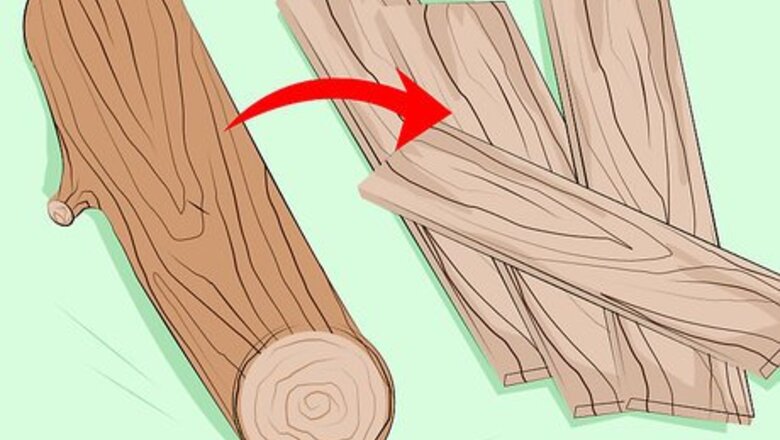
views
Preparing the Wood
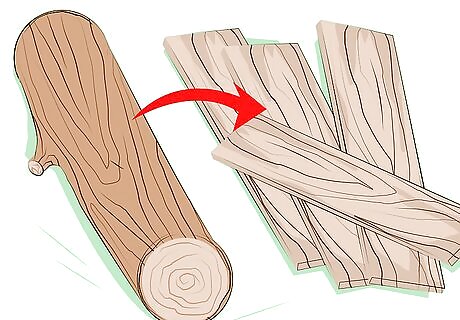
Process the wood. Logs should be processed into lumber as soon as possible to prevent the ends from drying and the wood from rotting. While the ideal thickness for lumber is 1 inch (2.5 cm), you may saw your logs into lumber that is between ¾ inch to 2 inches (5.1 cm) in thickness. If you are processing the wood yourself, make an effort to achieve uniform length and thickness. If you are unable to saw your own logs, find a sawmill to do the job for you. You may wish to cut your wood slightly oversized to account for shrinkage.
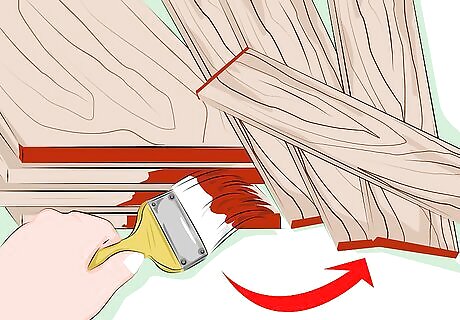
Seal the ends of the lumber. The ends of lumber cure faster than the rest of the wood. To ensure that your wood cures evenly, it is best to seal the ends immediately after sawing the logs into lumber. You may coat each end of the wood in a commercial end sealer, paraffin wax, polyurethane shellac, or latex paint. Build up a thick layer of the sealer of your choice to prevent moisture from escaping out of the ends.

Determine its cure time. When air-drying your wood, the curing time is determined by a simple formula. Allow 1 year of drying time per 1 inch (2.5 cm) of thickness. This formula only provides a rough estimate. It does not account for all variables, such as the weather and the location of the woodpile. For example, if a piece of wood is 1 inch thick, it would take 1 year to properly cure the lumber.
Selecting the Space and Stacking the Wood
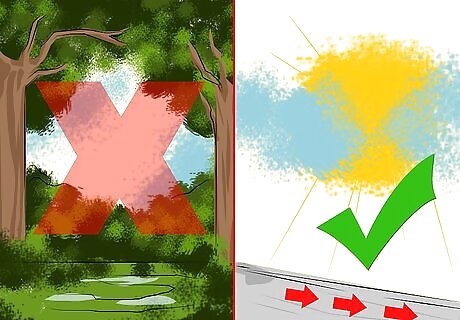
Identify an ideal curing location. When you are air-drying your wood, the lumber is left outside, exposed to the elements, to cure. Search for a location that meets the following requirements: To maximize airflow, select an outdoor location that is not surrounded by buildings or foliage that block the wind. Choose a location that has a slight slope to prevent water from gathering below the lumber. Find a spot that is not covered in foliage—foliage will expose the bottom layer of lumber to moisture. Lumber stacked on asphalt or concrete cures faster.
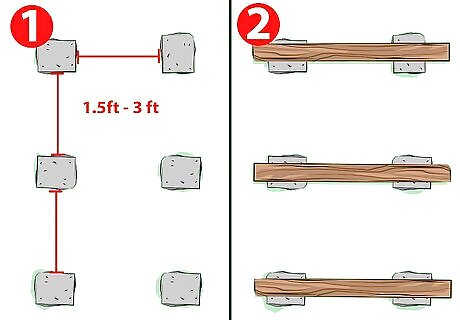
Prepare the foundation of the stack. In order to cure properly, lumber must be stacked in a very specific manner. Begin by creating a secure base for your lumber: Lay out two rows of three evenly spaced concrete blocks. The rows should be the same length as the lumber. The columns should be approximately 1 ½ to 3 feet apart. Lay a bolster, a 4x4 piece of wood, across each set of two concrete blocks.
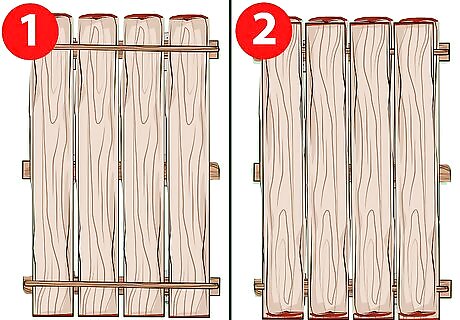
Stack the wood and stickers. To allow air to flow freely through the pile of lumber, stickers, ½ inch to 1 inch (2.5 cm) strips of wood, are inserted between each layer of lumber. Place 5 to 6 pieces of evenly spaced wood on top of the bolsters. Each piece of lumber in a pile should be approximately the same length. Place one sticker across each set of ends. Place additional stickers every 18 to 24 inches (45.7 to 61.0 cm) down the length of the lumber. Repeat the process, stacking the successive layers of lumber and stickers in exactly the same locations as the previous layer, until all of the lumber is in the pile.
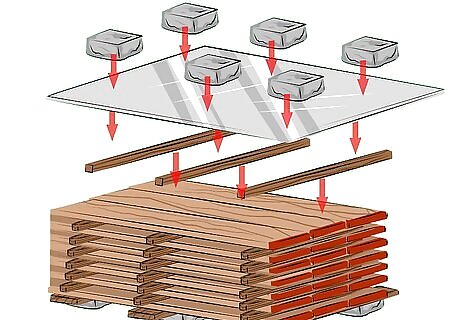
Create a weighted roof. A weighted roof covers the lumber to protect it from rain and snow. To make the weighted roof, do the following: Retrieve several 4x6 inch timbers that are 6 to 8 inches (15.2 to 20.3 cm) longer than the width of your pile. Place one timber across each end of the pile. Place the remaining timbers evenly down the length of the pile. Retrieve a sheet of metal that is 3 to 4 inches (7.6 to 10 cm) longer than the pile on each side. Place the metal sheet on top of the timbers. Place cement blocks on top of the metal sheet to keep the roof in place. Place the cement blocks in direct alignment with the stickers.
Monitoring the Process

Evaluate the wood’s moisture content frequently. The quality of your cured lumber is dependent upon the drying rate. To ensure that your wood is curing at an appropriate rate, you should monitor the moisture content of the lumber every 1 to 3 days. You can evaluate moisture content with an electronic meter. Use your readings to determine the target moisture content for your lumber. Air-dried wood’s final moisture content typically falls between 20% to 30%.
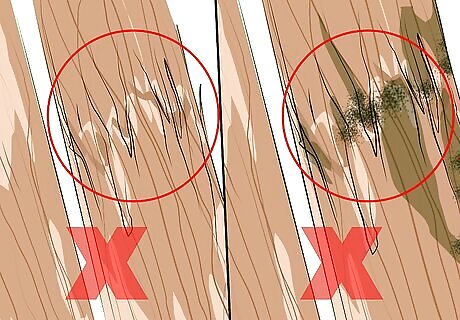
Search for drying defects. When wood cures too quickly or too slow, the makeup of the lumber is altered. If your lumber is drying too quickly, you may notice checking, or lengthwise cracks in the fibers of the lumber, splitting, honeycombing, or warping. If your lumber is drying too slowly, you may notice stains or areas of decay.

Make any necessary adjustments. If your wood is not curing at an appropriate rate, you should alter the structure of your wood pile. To reduce checking, consider trying the following: widen or double up your stacks, reduce the space between the pieces of lumber, use thinner stickers, or cover the pile with a shade cloth to protect it from the sun. To reduce warping, consider trying the following: align the stickers directly on top on each other, use uniform stickers, make sure each layer of lumber contains pieces of wood that are relatively the same thickness, or place a roof on top of the pile. To reduce staining and decay, consider trying the following: decrease the width of the pile, increase the space between piles, increase the space between layers of lumber, or clear the air of items that obstruct air flow.
Considering Alternative Curing Methods

Consider curing your lumber in a shed with fans. Instead of fully exposing your pile of lumber to the elements, you may choose to stack your wood in a shed. The shed must be open to the elements on one side and contain a series of fans on the opposite side. The fans force air through the stacked wood and decrease your curing time.
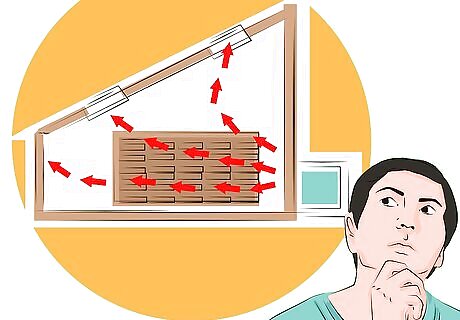
Consider force air-drying your lumber. If you have the resources, you may consider constructing a ventilated dry kiln. Locate or construct an enclosed building that contains fans capable of moving and recycling hot air. Place your stickered lumber inside the building to force air-dry or pre-dry your lumber.

Consider drying your wood in a kiln. For a price, many sawmills will cure green wood, or freshly milled wood, for you. The cost is often offset by the speed with which the job is completed. Most mills will use industrial sized kilns that are controlled by computers. Sawmills can use their software to determine the ideal heat setting based on the type of wood involved, the moisture content that is present, and the amount of wood that is being cured.



















Comments
0 comment